
Arts & Entertainment
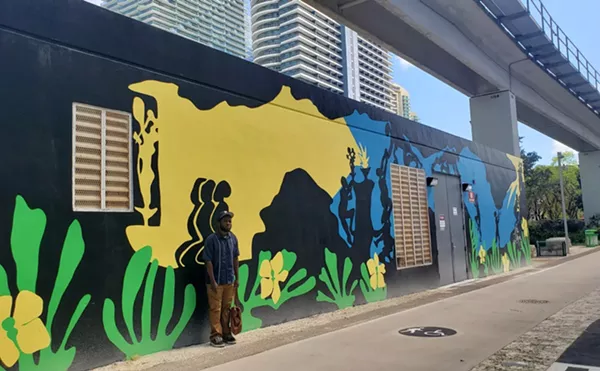
In Brickell, along the Underline public park — you know, the recently activated and colorfully greenspace under Miami's Metrorail tracks — there's tons of public art to interact with. You've got a functioning, Ping-Pong table by artist Cara Despin, you can often find a painted piano available for play, and then there's Edny Jean Joseph's The Allegory. Occupying an entire wall near the Brickell Metromover station, the Matisse-like mural depicts a group of workers silhouetted in black juxtaposed with larger-than-life yellow flowers and a blue sky. There's significance at work here: Although Joseph himself is Haitian, he chose to paint a mural alluding to the contributions Bahamian immigrant laborers made to the early development of Miami. The yellow, black, and blue color scheme pays homage to the colors of the flag of the Bahamas.
First they came for the Kendall boss babes, and we did not speak out. Then they came for the clout demons, and we did not speak out. Then they came for Miami New Times and — oh, shit. Eventually, Starter Packs of Miami comes for us all. The big-time Miami-Dade meme accounts could never, but Starter Packs goes there, with niche references to Liger's cookies, Andrew merch drops, and the literature available for purchase at Paradis Books & Bread. Flanigan's-loving Salt Life bros and Éliou-wearing microinfluencers get equal play. If astrology is your personality, natural wine is your hobby, or Carbone reservations are your currency, beware.
After hosting a rager at her $6.7 million Miami condo during Miami Hack Week — complete with lemurs, tech bros, and one massive snake — tech developer-turned-investor Lucy Guo tweeted a scathing letter she received from her homeowners' association that detailed how the party spiraled out of control and violated a handful of rules. "My HOA did not appreciate my Miami Hack Week party and the wild animals," she wrote in the since-deleted tweet, which included the note from One Thousand Museum Inc., the private corporation that enforces the bylaws at the striking 62-story luxury high-rise where Guo resides. After laying out Guo's various alleged offenses, the pissed-off association concluded, "All while your Instagram account provides evidence of the events of the night and your brazen attitude toward the Association's policies are reflected in the caption of your Instagram Story "MY HOA HATES ME."
Menephta Fernandez
$800,000 for that shithole? That's pretty much the entire premise of Menephta Fernandez's darkly hilarious TikTok videos. The self-appointed chisme real estate critic provides ruthless takedowns of the most indefensible listings on Miami Zillow. $625,000 for a log cabin in Biscayne Park that "might be" made of Dade County pine? Sure. $1.9 milli for a geodesic dome with a pink bathtub in North Miami Beach? OK. $895,000 for a Pinecrest home with shag carpet and an avocado-colored dishwasher? That's the market, baby! South Florida real estate agents are already freaking out about Fernandez's videos — at least one has objected to her use of "private" photos. "The MLS is not the Illumi-fucking-nati!" Fernandez clapped back. Then she let out her signature cackle — and kept recording.
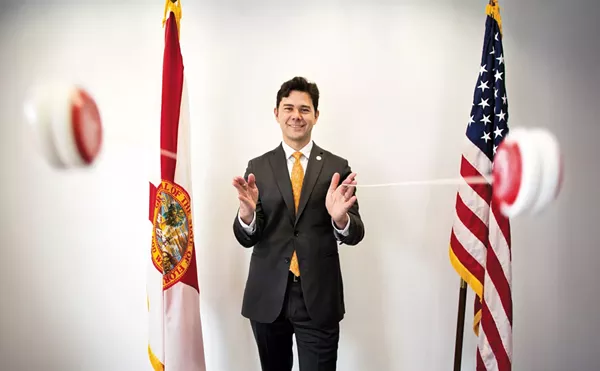
Miami City Commissioner Ken Russell may have lost some fans in Miami following a swing vote that cinched approval of the contentious Inter Miami FC stadium project, but he has no shortage of TikTok followers. The former international yo-yo champ-turned-politico, who recently pivoted from the U.S. Senate primary race to a run for Congress, shares daily clips on his account @kenforflorida that cover everything from cannabis policy to how to solve a Rubik's cube with one hand. Despite occasionally giving off "How do you do, fellow kids" meme energy in his videos, which usually are taken in selfie mode and follow popular TikTok trends, Russell actually seems to be engaging community members on topical issues like medical marijuana, police reform, and the rent being too damn high. As of late May, he'd amassed more than 250,000 followers.

With its postcard-perfect images of the Brickell skyline and art deco buildings, Miami has long been ready for its close-up. But no one has shot the city more intimately than artist, photographer, and graphic designer Laura Paresky Gould, who runs the popular Miami Color Theory Instagram account, launched in January 2021. Using just her iPhone and a drone, Paresky Gould captures the colorful shapes and shadows of the city's unique architecture and composes them as if they were works of modern, abstract art. For example, at first glance, the bright orange eyebrow of a South Beach apartment and the worm's-eye-view of a Brickell skyscraper take on the geometry of a Mondrian painting. It's this perspective — exaggerating the smallest of details — that often stumps locals, who then peek at the comments to figure out what they're actually looking at.
A year ago, Eliana Salzhauer might have been named "Best Politician." She was then an elected commissioner in Surfside during the town's most trying time — the aftermath of the Champlain Towers condo collapse. But her true calling at city hall was holding developers at bay while acting as the chief dissenter to Mayor Charles Burkett, whom she (in)famously flipped the double bird during a Zoom meeting in 2020. Then came the elections in March, and both she and her nemesis lost their seats in a near clean sweep by newcomers. After the loss, Salzhauer indicated that she wanted to take a break from city meetings, but that turned out to be impossible. "I don't have the ability to take it easy when someone is taking a shit in my living room," she said with characteristic bluntness. Salzhauer says the new slate of commissioners is more pro-development than ever, especially the new vice mayor, Jeffrey Rose, a prominent home builder in the sleepy seaside burg just north of Miami Beach. So Salzhauer is bird-dogging the new commission like never before, calling out every potential conflict of interest and attempt to skirt setback rules or height limits. "They just put this entire town in a cage with the snake and nobody wants to look," she says. Her efforts and means may not always be polite or popular, but Surfside, you want her on that wall, you need her on that wall.
When resident demagogue Ron DeSantis announced, in the midst of our national gun-violence epidemic, that he wanted to make it legal for basically any yahoo to pack heat in public without a permit, it was gubernatorial candidate Nikki Fried who immediately smacked him down. "This is absurd political pandering from the governor of a state that has experienced some of the worst mass shootings in our country's history, in a nation where we have the highest rates of gun violence in the world," she stated. On the same day, Fried, using her power as the state's commissioner of agriculture and consumer affairs, suspended the concealed-weapons permits of seven January 6 insurrectionists. Need more convincing? How about someone who denied DeSantis' order to lower state flags to half-mast when corrosive hate-talker Rush Limbaugh passed on to Hell? She did that, too. Someone who's leading the charge on adult-use cannabis, you say? Check. The big question now is whether she can beat Charlie Crist, the all-time king of showing up, to secure the Democratic nomination for governor and square off against DeSantis one on one. It's a major task, but remember that back in 2018, she beat a rifle-toting Republican to become the only Democrat to be elected statewide. Translation: She has surprised before.

Ketanji Brown Jackson hasn't just made good, she's made history. In fact, no South Florida girl or boy has made a more profound mark on history. Yes, the late great Janet Reno, the first woman to serve as U.S. Attorney General, comes close. But to be the first Black woman named to the U.S. Supreme Court? Epic. And awe-inspiring. Jackson was born in Washington, D.C., but she grew up in Miami and her roots here run deeper than a live oak's. Johnny Brown, her father, was the lead attorney for the Miami-Dade school board; her mother, Ellery Brown, served as principal of the New World School of Arts. An uncle, Calvin Ross, was a Miami police chief. Jackson herself graduated from Miami Palmetto Senior High School, class of 1988. Not surprisingly, she's remembered by many as highly driven during her South Florida youth and made good during her senior year when she won the national oratory championship. From there it was on to Harvard — and now, history.

Yes it's true that Mario Cristobal is the second consecutive University of Miami football coach to "come home" to great fanfare and big dreams. And it's also true that the first one — the super-hyped Manny Diaz — lasted three excruciating seasons before the axe fell. Might Cristobal follow in those regrettable footsteps? Don't count on it. Cristobal comes here with an edge Diaz lacked, one sharpened during his last somewhat bitter exit from town. You might remember that back in 2006, at age 36, Cristobal was named head coach at Florida International University, a fledgling program coming off a winless season. He significantly improved the team, which won a bowl game in 2010 and went 8-5 in 2011. But after a losing record the following year, he was abruptly canned. The decision was widely considered rash and unwise, and Cristobal has since proven it so. After being snapped up by a small football program called Alabama as O-line coach, he landed the head-coaching post at Oregon, where he went 35-13 over the last five seasons, was named Pac-12 Coach of the Year, and won a Rose Bowl. Now the second-generation cubano comes back to his hometown to coach the ex-powerhouse school with the big duck as a mascot (yes, we know it's supposed to be an ibis, but at games it looks like Donald Duck's slightly shady cousin and don't try to tell us otherwise). Will he return UM to its long-lost glory? Who knows, but it's a good bet he's gonna prove any doubters wrong.
There was a time when Jody Tagaris wasn't infamous for being crazier than a shithouse rat. In fact, as a former member of the GOP executive committee and Palm Beach County Commission candidate, she was a member of Republican royalty before it went totally in-your-face-death-cult fascist. Like so many of her ilk, it was January 6 that really brought out her Dark MAGA soul. On that day, the 67-year-old Tagaris put on her MAGA cap, her U.S. flag scarf, and her flag windbreaker. How do we know what she was wearing? Because she posed for photos while she was breaking into the Capitol, of course. In one she posed while climbing through a smashed window to the building ("Got tear gassed but okay!" she posted on Facebook.) Tagaris pleaded guilty in December to violent entry and disorderly conduct on Capitol grounds — a misdemeanor punishable by up to six months in jail and a fine of $5,000.

It's not because Kodak Black (né Bill Kahan Kapri) unironically glorifies criminal culture and greed. Or that he constantly has ugly-ass run-ins with the law. Those are staples for a certain brand of rap star. Though we should have, we didn't completely write off the famed Pompano Beach-born mumbler when he livestreamed an unidentified woman performing oral sex on his crew in a hotel room (while at that very time Black was facing criminal charges that he raped a woman in a another hotel room). That he has publicly demeaned black women and propositioned the girlfriend of the great Nipsy Hussle less than a week after Hussle was murdered should have been enough to end it for good with him — but somehow it wasn't. The last straw wasn't even his support for birther king and "fine people" admirer Donald Trump's re-election bid before the bag of orange goo commuted Kodak's 46-month prison sentence on a federal weapons conviction. The last straw broke in March, as the ex-prez continued to attack the democracy, well after a blatant attempt to steal the presidency, that Kodak again professed his love and announced that "getting rid of Trump was the worst thing America could've did." It was a reminder that he's a bad dude in the worst and most thorough way — and the last thing we need is more Kodak moments.
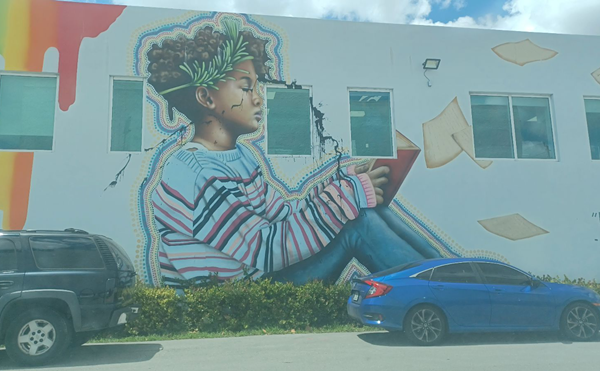
Miami-Dade Teachers Union
If art is meant to challenge conventionality, then it's no surprise when controversy follows. Though outwardly unassuming — an innocuous depiction of a Black girl reading books — the wall mural painted on the side of the United Teachers of Dade (UTD) union's headquarters in Miami Springs was, until recently, the flashpoint of small-town politics. In addition to brazen vandalism that saw the mural's main figure splashed with black paint, the mural came under fire from members of the city council because it didn't conform to the sleepy municipality's requirements for a limited color palette in the 36th Street district. Following heated debates and a contentious council vote, the teachers union prevailed. UTD was allowed to keep its public art on display for pedestrians to enjoy and reflect on the fitting Maya Angelou quotation it bears as an epitaph: "But still, like the air, I'll rise!"
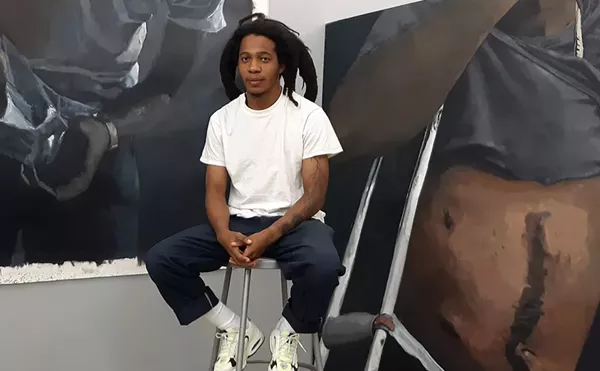
Reginald O'Neal paints like one of the greats. His works are both captivating and engaging, each brushstroke telling a story all its own. The 30-year-old artist specializes in figurative art, painting still-lifes based on autobiographical photos. A pair of his grandmother's glasses, a golden trumpet tree in full bloom, a haunting image of his father wearing a prison jumpsuit are just a few of O'Neal's most recent subjects. He's inspired by the world around him as well as his family and friends. In late 2021, during Miami Art Week, O'Neal had his second solo show at Spinello Projects, Pérez Art Museum Miami and the Institute of Contemporary Art recently added his work to their permanent collections, and earlier this year the Rubell Museum commissioned the young artist to create two works.
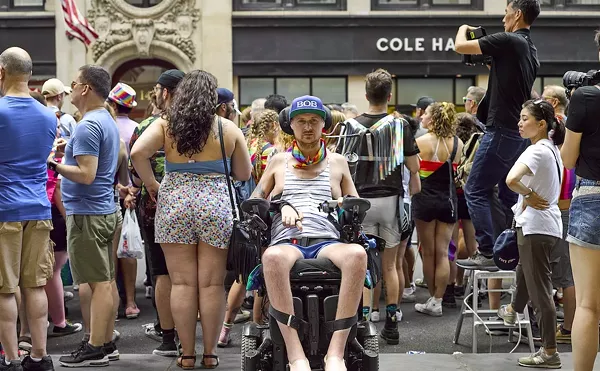
Robert Any Coombs can release the shutter on his Hasselblad and Polaroid cameras with his mouth. While it makes for a cool party trick, the logistics of photography are more complicated for the 34-year-old, who experienced a spinal cord injury in 2009. To bring his vision to fruition, Coombs often enlists photo assistants to help with his shoots, which may feature shirtless men, full-frontal nudity, and lots of touch. The artist's largely autobiographical work is at the intersection of disability, queerness, and sex — it's an expression of his sexuality that transcends his body's ability to perceive it. His images have been featured at the Patricia & Phillip Frost Art Museum at Florida International University and at the Photo Vogue Festival in Milan. Earlier this year, Coombs was awarded a $50,000 United States Artists Fellowship.
Graffiti artist Hiero Veiga's incomparable attention to detail might actually help you recall your wildest acid trip. The artist visualizes his carnal takes on psychedelics, love, self-identity, and street life through astonishing whimsical hyperrealism — a rare sight amid the animated street art Miami is best known for. His ambition to create wall art far exceeds the legal risks, even if that means no remuneration for his work. Sometimes it's easy to get trapped inside Miami's art trends, but Veiga stays true to his Boston roots by traveling regularly and grounding himself with support from Miami graffiti group, MSG (or as Veiga tells New Times, "It could mean Miami Style Graffiti, Maximum Satisfaction Guaranteed, Family and Love — whatever you're feeling").
The most satisfying aspect of HistoryMiami is in its name. They preserve history — the best moments, the not-so-great ones, and the ones we'd give anything to forget. They're committed to telling the larger community's story, often through the people themselves. One of the museum's recent exhibitions, "It's a Miami Thing," celebrated the city's 125th anniversary and featured items from the archives as well as some that were donated by residents. HistoryMiami often puts out a call for artifacts, asking Miamians to send in knickknacks that pertain to a certain theme or topic and share their unique story with the curatorial staff. You never know what nuggets might be uncovered thanks to those who've lived through it. Another great thing about the museum: It's located right near public transit, across the street from the Government Center Metrorail station and only a few stops on the Metromover away from the Perez Art Museum Miami and Frost Science. Consider that next time you feel the urge to go museum hopping.
Nina Johnson's eponymous gallery in Little Haiti started in 2007 as Gallery Diet in Wynwood — back when Miami's arts district was actually an arts district. But regardless of the gallery's name, Johnson has always had a knack for organizing museum-quality exhibitions while representing emerging artists like Emmett Moore, Bhakti Baxter, Katie Stout, and Savannah Knoop. Johnson has also organized shows around artists like Jim Drain, Marlene Bennett Jones, and Judy Chicago — established names worthy of solo exhibitions at PAMM or ICA. Whenever Johnson opens a new show, you'd be a fool to miss it.
Though the fact continues to come as a surprise to many, Miami is an exceptionally literary city. One contributor to this community is Fort Lauderdale resident Diana Abu-Jaber, whose recently published novel, Fencing With the King, is an update of classic themes from King Lear and Arthurian fables. Amani, the story's protagonist, discovers a poem by her grandmother, a refugee in Jordan during World War I, and investigates its origins through her Uncle Hafez, advisor to the King of Jordan. Tension escalates as Amani undertakes a complicated and dangerous journey filled with history and discovery. Outside of the fantastical stories she creates, Abu-Jaber is a writing and literature professor at Portland State University who splits her time between Oregon and Fort Lauderdale.
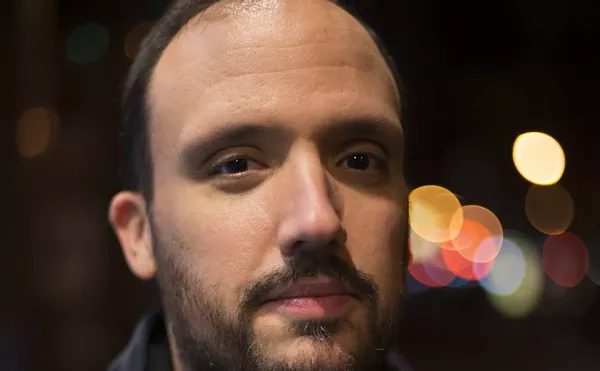
You can take the boy out of Miami, but you can't take Miami out of the boy. In no case does this ring as true as it does with Cuban-American author Alex Segura, a New York resident whose Miami roots find their way into all of his work, from comic books to novels. "I joke with people that there's always an element of Miami in everything I write," Segura tells New Times. Whether it's his crime noir series of Pete Fernandez mysteries or his recent, critically acclaimed novel Secret Identity, Segura's engaging figures always have a Magic City connection. His lead characters may even reflect the author himself. A former reporter who left South Florida, but who was left with an indelible mark by a hometown that many don't understand but everyone wants to know more about. "It's such a unique place — there's a duality to it as a tropical paradise with a lot of noir bubbling up under the surface, a lot of subtleties that people don't know about," Segura says. "It's also important to identify with these stories. I love mysteries, but I wanted to see more people like me as the star. I wanted to read about Hispanic protagonists, so I actualized the books I wanted to read."
Jacqueline Charles has been covering the Caribbean for the Miami Herald since 2006, and she's never stopped performing at the top of her game. This past year was no exception — Charles, a Pulitzer Prize finalist for her coverage of the 2010 Haiti earthquake, returned to the island nation after another horrific quake hit in August 2021, telling the stories of displaced Haitians once again faced with mass destruction of their homeland. She also continued to tirelessly report on years two and three of the coronavirus pandemic, picking up a National Headliner Award with her colleagues for a story on vaccine inequity in the Americas. As other U.S. newspapers scale back their international operations, Charles plays a vital, almost singular, role in covering political instability, natural disasters, healthcare inequities and systemic breakdowns of governments in the region. "When most people think about the Caribbean, they're thinking about travel and tourism and beaches," she told the Longform podcast. "...For citizens, the diaspora of these countries, what's happening at home is very important to them, so that's something I'm looking at."
The old adage goes, "a picture is worth a thousand words," and no one understands that more deeply than a photojournalist. Whether it's a protest, a sporting event, a parade, or anything in between, Miami Herald photographer Daniel A. Varela is on the job. His photos are as compelling as they are beautiful to look at. Not only does he capture the moment, but he captures the right moment — like the smile of a bystander at a Pride parade who doesn't know anyone's watching, or the concentration of tennis superstar Naomi Osaka at the Miami Open. Varela started his career with the Herald as an intern, moved on to a role as a freelance photographer and eventually, in 2019, a full-time staff photographer. No one said it was easy — though Varela often makes it look that way.
Calvin Hughes was a TV anchor in Philadelphia when he got the call that WPLG was looking to replace legendary local broadcaster Dwight Lauderdale. He accepted the job, envisioning his time in Miami as a two- or three-year stint. Instead, he's been telling the stories of South Floridians for more than 16 trips around the sun. During that tenure, the five-time Emmy Award winner has become a fixture in the community, reporting on the biggest news events to affect the Miami area and beyond. Last year, Hughes scored an exclusive interview with Martine Moïse, the widow of Haitian president Jovenel Moïse, who was assassinated when a group of gunmen raided the couple's home in July 2021. Martine, who was shot multiple times during the attack, told Hughes that, in her state of grief and shock, she went a week without sleeping or eating while in the hospital recovering. Those are the kinds of intimate revelations Hughes, an empathetic listener and skilled interviewer, is deftly able to capture for the viewers back home, week after week after week.
If you've spent any amount of time in Miami during hurricane season, chances are you've heard or seen the name Brian McNoldy. A senior research associate at the University of Miami who studies hurricanes, climatology, and sea-level rise, McNoldy is Miami's de facto hurricane expert, long relied upon by the press and public for insight in the face of oncoming tropical storms. His fascination with weather began at age 7 with the Megapolitan Blizzard of 1983 and since the late '90s he has maintained a Blogspot site, Tropical Atlantic Update, where he provides context-rich updates in a digestible and engaging way. He's perhaps best known for regularly sharing interesting climatology facts and keeping Miamians updated on the weather via Twitter @BMcNoldy.
Remember 2015? It was a strange year for local music thanks to one massive void. WZTA – the area's only alternative station – disappeared in February of that year and, for six long months, rock lovers had nowhere to tune. Then an angel arrived, in the form of 104.3 FM "The Shark." Seven years in, the Shark has become a Miami rock mainstay, with weekly shindigs like Emo Nite and Alternalido (Latin jams) on Sundays and loveable weekday deejays like Ashley O and Dallas making miserable South Florida traffic (almost) bearable. Now under the Audacy umbrella, its annual festival on Fort Lauderdale Beach (known as Audacy Beach Festival) has been taken to the max, with Twenty One Pilots, the Lumineers, Lil Nas X, and more gracing its main stage in the December 2021 edition. In oh so many ways, the Shark rocks — and it had better not even think of leaving us.
What do you say about the man that has seen, done, and talked about it all throughout his illustrious radio broadcasting career? You point out how his public love affair with the McDonald's McRib — without pickles, by the way — is a horrific food take, but he is loved anyway. Hochman is like the LeBron James of sports radio: He makes everyone around him better. His current domination of the afternoon drive simulcast on both WQAM and 790 The Ticket (WAXY) is akin to LeBron playing for the Lakers and Clippers simultaneously. Could he do it? Probably. Does Hochman do this daily? Yes. Advantage, Hochman. The trifecta of Hochman, Channing Crowder, and Alex Solana on the airwaves every day makes South Florida that much better of a sports town. And it makes us incredibly thankful.
Journalists get a lot of emails. Like...a lot. When publicists send their generic pitch letters with that standard copy-and-paste language where they just change the name up top (and sometimes forget to do even that), they're almost surely bound for the trash bin, unread. The mark of a good flack is one who does the research. And it shows. Abbie Lipton of Durée & Company will never, not ever, send you a generic pitch. She tailors her emails to the reporter and pitches stories the writer would likely take an interest in. The account director represents a range of clients, from art to food, including the Museum of Contemporary Art North Miami (MOCA) and the Eat Me Guilt Free brand. She also knows that building individual rapport with a reporter goes a long way. When a writer receives a pitch from Abbie, both parties are aware that it may well turn out to be a good story.
According to U.S. News & World Report's exhaustive study of 24,000 public high schools in the nation, the School for Advanced Studies isn't just the best school in Miami, it's the best in the state of Florida, and fourth-best in the entire country. Spread out over Miami Dade College's five campuses (Homestead, Kendall, North, West, and Wolfson), SAS allows high school juniors and seniors to use their last two years to a head start in college by simultaneously earning their associate's degree. A public institution, SAS is open to any Miami-Dade resident who meets the grade and testing requirements with an impartial lottery deciding who gets in in the event there's an excess of qualified candidates. Merit mixed with luck — it's an admission policy that makes for a student body that matches Miami's diversity.
An up-and-coming director must possess authenticity, tenacity, and above all, curiosity. Chris Molina possesses all these traits, making him an exciting, emerging filmmaker. Over the past few years, he's been a behind-the-scenes fixture with various film productions, festivals, and collectives, absorbing the film culture of South Florida. He's channeled that energy into his own films, like the confessional and insightful, Is That All There Is? (2020), and, most recently, The Truth of a Thousand Nights (2021), which won "Best Film" at this year's Miami Film Festival. Molina has also supported his fellow filmmakers through the creation of the Sun Pass Film Festival and its new offshoot, Anita's Film Festival. That kind of involvement is essential to Molina's own art. Already a two-time Sundance Ignite finalist and recent artist-in-residence at Oolite Arts, Molina is becoming a marquee name in South Florida's film scene.

Billy Corben and Alfred Spellman, founders of the production company Rakontur, have been friends and filmmaking partners since their high school days in the 1990s. In fact, they snagged this honor last year for 537 Votes, an incisive look back at Miami-Dade's pivotal role in the 2000 presidential election. But their 2021 documentary Cocaine Cowboys: The Kings of Miami, just might be the most #BecauseMiami tale of them all. The six-part docuseries opens with a catchy theme song by local boy Pitbull and chronicles the story of how local childhood pals Augusto "Willy" Falcon and Salvador "Sal" Magluta (AKA Willy and Sal) went from dealing dime bags to controlling America's most robust cocaine empire during the 1970s and '80s. Through archival videos and interviews with former prosecutors, drug smugglers, and journalists, the series illustrates how the duo trafficked millions of dollars' worth of cocaine from Colombia into the United States, all while somehow staying one step ahead of the law. The series, available for streaming on Netflix, is the third in Rakontur's Cocaine Cowboys series and draws heavily on former New Times staff writer Jim DeFede's dogged coverage of the rise and fall of Willy and Sal. Slow claps for local journalism!
Do you dream of a shirtless Hugh Jackman floating in a water tank with suction cups stuck to his head? Have you wondered what Miami will potentially look like if we ignore rising sea levels? Don't worry, we'll have rowboats. Although Lisa Joy's (Westworld) 2021 sci-fi thriller Reminiscence was mostly filmed in New Orleans (one of the main locations was that city's abandoned Six Flags — creepy!), the production crew shot aerial drone footage of the Magic City, then CGI'd permanent high tide and dreariness. The film scored a decisive 36 percent splat on Rotten Tomatoes and inspired New York Times critic Manohla Dargis to label it "highfalutin, lightly enjoyable mush." Thanks for the memories, Hugh!
The past few years have been a struggle for art houses around the world. Coral Gables Art Cinema, along with O Cinema and the Tower, have made it through those dark times. This year, Gables set itself apart by continuing its commitment to connecting the community through carefully curated cinema programming and adding a fresh point of view. That new perspective came in the form of filmmaker April Dobbins taking the role of programming director. In addition to standard art-house fare, like the latest Almodóvar and Oscar nominees, Dobbins' keen eye brought in adventurous films like The Pink Cloud, the daring Gagarine, and future cult classic Strawberry Mansion. Politically charged cinema from Chad (Lingui: The Sacred Bond) and Palestine (Huda's Salon) offered thought-provoking tales from nations underrepresented in mainstream curation. Perhaps most memorable and impactful, "Strong Black Leads," a ten-film salute to Black cinema, eclipsed the perfunctory Black History Month programming of the past, pointing to the depth and variety of Black representation in American cinema. This was the year the Coral Gables Art Cinema underlined the "art" in art cinema.
A fixture in South Miami since the late 1990s, the AMC Sunset Place 24 continues to offer blockbuster films, award contenders, and international and independent cinema. With a whopping 24 screens in operation, it is a bona fide megaplex that offers a variety of options for your viewing pleasure. The mall where it resides has seen better days, but you can still find great places to eat and drink before or after the movie. In contrast to some newer theaters in the area, Sunset keeps costs relatively reasonable and offers a discounted ticket on Tuesdays. Equipped with 3D, IMAX, and Dolby Cinema, AMC Sunset Place 24 beats sitting on the couch when you want to watch a big, brash Hollywood spectacle. It's what Nicole Kidman means when she says, "Dazzling images on a huge silver screen. Sound that I can feel."

Miami New Drama does the opposite of what many other theater companies do: It purposely avoids the well-known crowd favorites. While Broadway hits and other popular productions rake in ticket sales elsewhere, Miami New Drama eschews the status quo with seasons that consist of mostly new, world premiere plays and musicals. They proudly embrace their role as a smaller, hyperlocal theater company by aiming their work directly at Miamians, with stories that reflect the city's culture. The Cuban Vote, an iteration of Shakespeare's Taming of the Shrew, premiered at the Miami New Drama's home base, the Colony Theatre in April 2022, exploring local politics. During the height of the pandemic, when many theater artists were jobless, the company produced"The 7 Deadly Sins," a series of seven commissioned short plays performed in empty Lincoln Road storefronts for limited audiences. That bold risk paid off when "Sins" won a 2021 Drama League award for Interactive or Socially Distanced Theater, placing MND on the national stage. Bravo!
Known by her fans as "La Barbie Dominicana" — or Dominican Barbie — this Miamian has become a total mainstay in TV, theater and film in Miami, the U.S., Dominican Republic and well beyond. Spanish speakers will know Wendy Regalado from the hit Nickelodeon telenovela Grachi, where she played Lucía. She's also starred as Dulce in La Suerte de Loli on Telemundo and La Fuerza de Creer 2 on Univisión. Earlier this year – and perhaps her biggest gig to-date – she wrapped filming for the new Disney+ Latino miniseries 4Ever with Latin music mega-stars CNCO. As for local theater, she's appeared in several recent Miami productions, too, spanning "Bodas de Sangre (Blood Wedding) at Goodlet Theatre and Performing Arts Center to Much Ado About Nothing at Trail Theater. In between all of her entertainment endeavors, she even hosts her own Wellness by Wen digital program focused on nutrition, beauty and wellness. Regalado is as dynamic as it gets and is Miami's shiniest star here in 2022.

Founded in 2000 by Hannah Baumgarten and Diego Salterini, Dance Now! Miami has become one of the city's most respected dance companies thanks to its focus on modern and contemporary dance. From traditional programs on the stage to immersive site-specific productions, Dance Now! Miami pushes forward what dance can and ought to be in the 21st Century. It prides itself in teaming up with other artists and dance companies, like its recent collaboration with the legendary Limón Dance Company. DN!M presents various series throughout the year, including Masterpiece in Motion, which honors dance's rich legacy, and New Voices, in which choreographers from across the U.S. expose Miami audiences to new trends in dance. Miami is certainly a cosmopolitan city, but it's nonetheless impressive thatsuch a forward-thinking company calls our city home.
They don't call Sin the "ass of South Florida'' for nothing. Pole dancers and burlesque performers alike are often left out of the "dancer" quota, but leave it to Sin Silva to effortlessly merge the gap. Their seductive spectacle entices audiences of all kinds with an androgynous showgirl-meets-drag aesthetic. From fire-eating to whip-cracking, Sin is modernizing and redefining the world of burlesque. Each flip, dip, and kick makes watching them feel like...a sin. Catch them Friday nights starting at 8:30 at the Outcasts Show at Georgie's Alibi Monkey Bar (2266 Wilton Dr., Wilton Manors; 954-565-2526; alibi.lgbt).

Nicky Monet might have been born a star. Raised in Florida, she entered the entertainment industry at an early age, appearing on Nickelodeon as a backup dancer for 'Nsync. A sojourn in Los Angeles saw her become a reality-TV fixture,— appearing on Keeping Up with the Kardashians, Slag Wars, Iconic Justice, and Hot Haus. Now she's come full circle: It's our luck that she can now be found performing all over town — at the Palace in South Beach, at bars in Fort Lauderdale, and at Double Stubble at Gramps in Wynwood, to name just a few. A trans model, drag queen, and burlesque artist, Monet captivates with her command of the stage — she must be seen to be believed. She's seductive and powerful, hilarious and candid. Her electric energy pulsates each and every time she takes the stage.
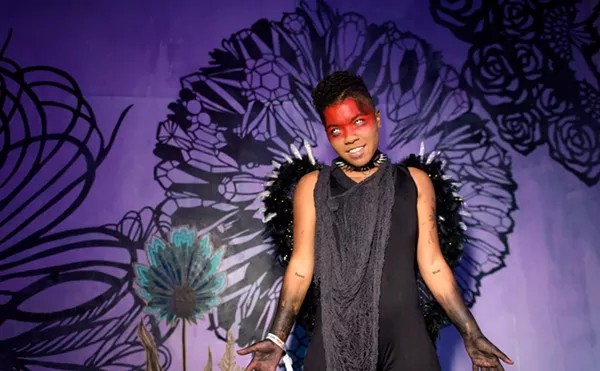
If you haven't seen King Femme live, you're missing out. (And frankly, we're concerned.) The nonbinary drag king began performing in 2017, flaunting a fierce makeup mustache, occasional lace-front wigs, and the smooth vibe of a '50s jazz bar. In short, they brought the queer, Black, androgynous representation Miami's drag scene desperately needed. From cowboy chic to leather angel, King served as a heroic symbol, especially for gender-diverse people of color. You automatically knew it was a party with King Femme on the lineup. But their drag persona was just half of the craze. King (who goes by Eli Sage Rosenberg out of drag) fundraised and donated free chest binders, publicly documented his medical transition journey, and now educates about mental health, diversity, equity, and inclusion — all in order to encourage others to embrace their authentic selves.

Poetry might not be the first thing that comes to mind when you think of Miami's creative scenes. But the O, Miami Poetry Festival continues to challenge that stereotype with its engaging and inventive programming. Held annually with the mission that each person in Miami-Dade will encounter at least one poem during the month of April, O, Miami is a powerful lesson in nonprofit arts programming. Engineered all year long and ranging from large-scale to intimate projects, with ideas sourced from locals, the festival is a testament to community building through the arts. The festival spotlights the poetics of cinema, music, performance, art, and technology. Its dedicated and adventurous staff works tirelessly to create an event that's accessible, equitable, and inclusive. A wonderfully unique and evolving entity, O, Miami Poetry Festival remains one of the city's most imaginative and disarming festivals.
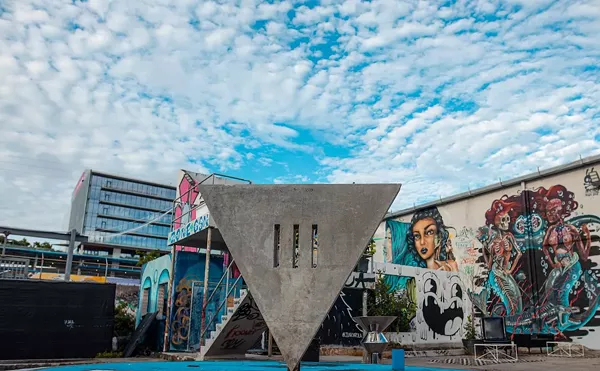
In today's cutthroat festival world, everything has to go perfect before making it to year two. Yet III Points has always thrived on adversity, which may be its secret sauce. The latest test, aside from COVID-19, was condensing to two days from its habitual three-day roaster. No biggie. With a restless lineup of purebred talent and a seismic crowd, the festival made up for lost time. III Points brought the Strokes back to Miami from a lengthy hiatus, wooed the crowd with Rüfüs Du Sol, and pushed the limits of one stage with Peggy Gou. Presale tickets for 2022 are on sale and they've already started teasing the lineup by announcing its first headliner: Rosalía. III Points 2022 is scheduled for Friday, October 21, and Saturday, October 22.
Sixty-plus years into its Miami Beach journey, the Fillmore continues to strike the perfect balance. There's so much to love about this 2,500-ish-capacity room, which occupies a sweet spot between mega-venue and teeny-tiny club — its Art Deco allure, its South Beach proximity to post-concert shenanigans, the steady flow of big names rocking its fully equipped confines. Among those to grace its stage in recent years: Madonna, New Order, the Kid Laroi, and Death Cab for Cutie. All of which makes it nearly incomprehensible to imagine living without the place — something we're going to have to do for the next 12 months as construction commences on Miami Beach's new, 800-room Grand Hyatt Miami Beach Convention Center Hotel right next door. It's going to be a long year.
Sure, Miami has an endless supply of opulent nightclubs and no shortage of DJs, but if you're a denizen looking for a break from the tiki-tiki sounds of Miami Beach, head to the Anderson. Housed in the former Magnum Lounge, the Anderson continues its predecessor's legacy with nightly entertainment ranging from Latin jazz to reggae, rock 'n' roll, and everything in between. Once inside, you'll time-travel to an analog age courtesy of the venue's retro motif. Grab a seat underneath the glistening disco ball and indulge your ears with the sounds of some of Miami's greatest local acts.
While the pandemic forced many local-music institutions to unplug the soundboards, Wynwood's granddaddy of bars, Gramps, has continued to amplify the best acts the South Florida scenes have to offer. The venue has consistently given local acts priority for a variety of exposure— from record-release parties to DJ sets to booking them as openers for nationally touring artists — building a deserved reputation as the place to check the pulse of Miami's native sound. The outdoor stage allows for a larger crowd to dance to the beats or nod along as they chow pizza and slurp beer. And the Shirley, Gramps' more intimate back room, has become a refuge for occasional jazz jams.
Okay, the Flamingo Theater Bar at the Four Ambassadors is not a "club," per se — but it regularly books some of the best Latin music-centered shows in the city. The theater, along with its sister venue, La Scala de Miami (also located in the Four Ambassadors), has artists from Cuba, Venezuela, Colombia, Argentina, and Puerto Rico grace its stage, keeping Miami's diasporic communities connected to their cultures. ChocQuibTown, Jacob Forever, Carlos Varela, Julio Iglesias, Jr., Los Amigos Invisibles, and Daniela Darcourt have all performed here. And while it's not a nightclub, that doesn't stop people from getting up and dancing at shows. Tickets are typically priced in the $50 to $60 range but be aware that you usually have to spring for a whole table. (Some tables are two-seaters.)
It is hard to believe that only five years ago, applicable adjectives to associate with Club Space would have included "seedy" and "grimy" –– in other words, flat-out unwelcoming. But ever since new owners took the reins, the club has dusted off the curtains and let the sun shine through to the terrace. Disco balls and lasers, hanging foliage and a cigarette-free environment, plus star-studded lineups that rival Ibiza? Who's to quibble? Space ushered in a residency with Macro Carola, and brought Ricardo Villalobos (twice) and the legendary Carl Cox. The twin tricks to the club's success: collaboration and investing wisely. Space interact with the community via free weekly yoga, sound buffering, and a scholarship fund. The sound system levels every room with bass and leavens 'em with pristine hi-hats, but to dance there is to experience club culture as it used to be: for everyone.

A DJ's humble beginnings are seldom graceful. The success rate is modest: discordant transitions, lack of studio equipment, sound saturation. This, of course, pegs the meteoritic rise of Layla Benitez as an outlier. In little time, she has released EPs featuring her hot-pot blend of afro and deep house on big-name labels and has entertained crowds on the international scale. The Miamian debuted at Coachella this year and is set to take to Ibiza's White Isles — all while maintaining her resident duties at Club Space. Undoubtedly, being the daughter of legendary dance-music virtuoso John "Jellybean" Benitez adds a buffer to her learning curve, but Layla's music is unquestionably her own. She spins deep, akin to the South African-infused music of Black Coffee that is inherently hypnotic for sunset/sunrise hours. Often, you have to go to club X in Miami to find the "Best DJ" spin—but if you're so inclined, just buy a ticket to any spot, and you'll likely hear Benitez's spin under the sun or moon.

Dance culture has always revolved around hustle. Hustling to play the clubs, to release music, to get heard. INVT duo Luca Medici and Delbert Perez make the game look too easy. The 24-year-old Miami natives have taken underground dance music by storm with their nightmarish jungle and dubstep combos that link to the more traditional Latin and South American genres like reggaeton and cumbia. The sounds are cryptic and distorted, often driving the listener toward introspection. The team has self-released nearly 100 tracks along with pushing their own fashion brand. They've also collaborated with locals including Nick León and Coffintexts. The British DJ Ben UFO recently dropped their track "Sopla" in his latest Essential Mix, and they're set to join U.K. legend Skream in June. INVT's shining star is its live show, whose sets come equipped with a thick layer of analog gear and drums. Hands move quickly and heads bop in sync. Yep, stone-cold hustle.

On "Move Along," Mellow Rackz doesn't hold back. "The things I do ain't right/But I can't do no wrong/Yo bitch pulled up with no cheese/But pussy provolone/He fuckin' asked for my number/Type the digits wrong." It's evident the Young Money signee is pure South Florida. She has sex appeal to spare, but don't you dare cross her or you won't live to see another day. Rackz first made headlines thanks to her short-lived engagement to controversial rapper Kodak Black (see "Best Local Boy Gone Bad"), but since then, she has proven she's more than arm candy. Her flow is gritty yet full of braggadocio. Seriously, Mellow, give us the album already!

On her latest track, "How You Feel?" Natalie Foucauld brings her experimental indie-pop sound closer to the hyperpop aesthetic that's taking over the internet. It's not a huge leap for Foucauld, who has been taking pop music to exploratory extremes under the moniker Le Poodle. On the aforementioned track, Le Poodle and producer Richy B incorporate trip-hop and R&B melodies with a stuttering bassline. Foucauld's vocal delivery is also reminiscent of PC Music princess and proto-hyperpop act Hannah Diamond in that glossy imperfection, revealing a certain vulnerability often absent in mainstream pop. Overall, Foucauld's musical output is sparse, but when she releases a song, you can't help but be in awe of her natural talent.

Singer-songwriter Ryahn's music has a '90s quality that TikTok teens are going gaga over these days. But far from giving off a vibe that the 24-year-old is usurping trends she wasn't even around to witness, Ryahn is surprisingly genuine. Perhaps it's her husky voice that evokes comparisons to Toni Braxton, or that she looks so effortlessly cool in a Dionne from Clueless sort of way. Now based in Los Angeles, the Fort Lauderdale native seems destined to dominate the charts if the public catches up with her. On "Happening Again," her collaboration with Miami-based collective Frut, Ryahn makes a case for chart-topper status as she frolics against a beautiful California backdrop.
Gaiya's vocals are as effortless as her style. The Miami-bred singer sounds like a soulful cross between Amy Winehouse and Celia Cruz — a lethal combination in a rising young Latin star. Her live performances are electrifying; Gaiya feels the music moving through her as she lights up the stage, to the point where it's impossible not to find yourself swaying along to the beat in your seat. Best of all are the times when she riffs vocally during a set. That's the moment you know the music has overtaken her and it's about to sweep up the audience, too. Catch the songstress performing around town at places like the North Beach Bandshell and the Doral Yard. She's also a frequent performer at Isabella Acker's Tigre Den studio. Follow her via Instagram (@gaiyaoficial) for the early word on local appearances.

Any kid who grew up in 1990s and early-2000s Miami knows what a chonga is. It's that girl who always had her hair slicked back with industrial-strength gel in a messy bun held by a scrunchie or a big butterfly clip. She wore dark-brown lip liner, acrylic nails, and a Tommy Hilfiger windbreaker. Leave it to La Goony Chonga to keep championing chonga culture into the 2020s. She was living in L.A. until the pandemic brought her home — and thank God it did because La Goony Chonga is the epitome of "305 till I die." Of course, she's traveling the globe, performing across the U.S., Europe, and Latin America. She has earned props from Latin music icons like Ivy Queen and Rosalía. And her recent video for "Chongivity Activity" — shot in Miami (AKA Chonga City) — features a cameo from Miami's original viral chonga sensation, the Chonga Girls.

Self-described as a loud and messy rock 'n' roll band, Bruvvy has risen quickly to the top of Miami's rock scene. In fact, in April 2022, the quartet opened for Bon Jovi when the band stopped at the FLA Live Arena in Sunrise. Frontwoman and guitarist Liz Varum's vocals are mildly reminiscent of Tragic Kingdom-era Gwen Stefani, with a dash of "I Love Rock 'n' Roll" Joan Jett. And while the term "underground band" sometimes sends people scurrying back up the aisles, know that Bruvvy delivers unadulterated alternative and hard rock. When they aren't opening for Jersey rock legends, you can find them performing at venues like Las Rosas, PoorHouse, and the Bridge.

Uniting in Kendall during the pandemic's most monotonous days, the four members of Frogs Show Mercy bonded over a mutual passion for Midwestern emo and late-20th-century indie rock. Singer/guitarist Yucky Poor, drummer Javier Nin, bassist Karl Martinez, and guitarist Laz Matus utilized their boredom and restless hearts to create loud, rhythmic art. Over the past year, they've put out a series of four singles that, depending on your mood, could inspire you to dance, cry, or aggressively kick over a chair. "Hereditary" is a catchy track in its own low-key and lo-fi manner. "Echo Park" betrays an experimental, loungey dive-bar vibe, while "Love Witch" releases that bottled-up frustration we've all been feeling. The foursome's latest single, "PTSD," is perhaps their most epic, with an eight-minute running time that allows the listener to experience a range of emotions.
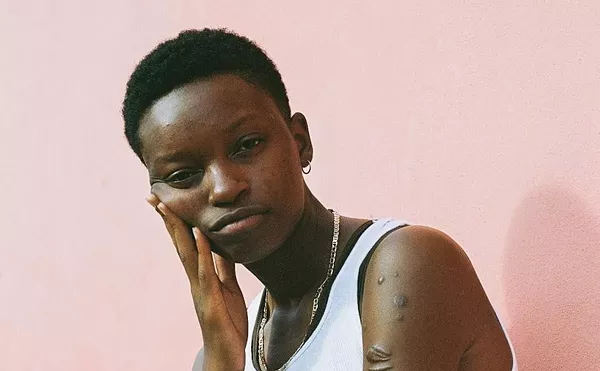
At the ripe old age of 21, Mikah Amani has already put out an EP and a full-length LP that embody a beauty and maturity that belie the singer-songwriter's years. Released in March, The Hooded Crow featured a dozen songs with probing lyrics and stunning instrumentation. Written and recorded in Miami while taking a leave from his creative-writing studies at New York University, Amani sings and plays guitar with the quiet, introspective vibe of a 21st-century Tracy Chapman. Many of the lyrics deal with Amani's experiences as a member of the LGBTQ+ community, whether dealing with unrequited queer love or coming out to a father who doesn't understand him. The beautiful thing about expressing these experiences through soulful music is that it allows personal struggle to be understood universally — by anyone.

Thankfully, Miami locals Seafoam Walls did the hard work of explaining their original sound to us. Who else could categorize their beautiful new album XVI as "Caribbean Jazzgage"? The collection of new songs indeed delves into jazz rhythms and shoegaze experimentation, all of it set against a laid-back island vibe. (Is that even possible? Yes, it is.) Founded in 2014 by singer/guitarist Jayan Bertrand, Seafoam Walls expanded with the addition of bassist Joshua Ewers, multi-instrumentalist Dion Kerr, and drummer Josue Vargas. The band's debut full-length got a boost in national attention when Thurston Moore, legendary frontman of Sonic Youth, became a fan and released the album on his Daydream Library Series label, which helped to attract attention from outlets like Spin and Pitchfork. And that attention came in the form of uniform admiration. But even with the band's apt and efficient genre-branding, XVI remains otherworldly and addictive — kinda like the city that spawned it.
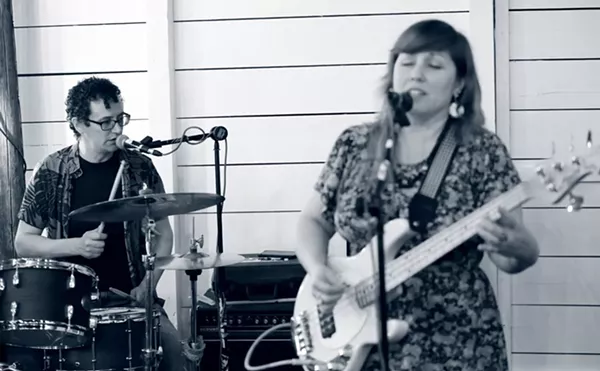
It wasn't enough for local husband-and-wife team Tony Kapel and Maitejosune Urrechaga to form the noise rock band Pocket of Lollipops. Their mutual love of music found them creating their own label, Houndstooth Cottage. Since its formation in 2013, Houndstooth has released more than 20 releases in formats ranging from vinyl to CD to cassette. The year 2022 is shaping up to be a busy one for HC, with upcoming titles including a solo project from June of 44's Sean Meadows, featuring sessions wherein he teaches guitar to villagers in Vietnam along with songs from his Kewl Haro project. Locals Ed Artigas & Ed Matus will represent the 305 with brand-new EPs. And an album is finally being planned for Lost Hours, the new band from Bobby Fay of Sebadoh.
As we enter year 17 of the great vinyl comeback, it makes sense that actual brick-and-mortar record stores are seeing a parallel resurgence. If listeners want their music to occupy a physical form, it makes sense they'd also want their shopping experience to be nondigital. North Miami's Found Sound Records hearkens back to a day when independent record shops were grounds for new discoveries and downloading wasn't even a word. Every Tuesday through Saturday, from 1 to 7 p.m., owner Ralph Pichardo sits behind the counter spinning vinyl, ready to answer customers' questions about everything from Father's Day gifts to why you might want to steer clear of that Legendary Stardust Cowboy album. The inventory of new and used records hovers around 8,000, including original pressings and other valuable rarities but also crates filled with LPs priced as low as two bucks.

Carlos Hernandez's comedy is rooted in the absurdity of living at the tip of the Floridian peninsula. "Hialeah, where you at?" The crowd roars. "Miami Lakes, where you at?" More cheers. "Miami Lakes is, like, pretending to not be Hialeah. 'We're here. There's, like, a little lake over there. It's fine. There's cows. There's no chickens here.'" Then he proclaims, "Doral in the building!" to silence, followed by hysterical laughter. From an outsider's perspective, it might not seem funny at all. But locals know that Miami Lakes residents turn up their noses at their neighbors in Hialeah and that Doralzuela was an industrial park not too long ago. The bilingual comedian regularly holds court at the Miami Improv as well as at comedy nights across the city, so you shouldn't have a problem catching his act in person. If convincing you requires a taste of his material, check out his TikTok (@cahrlol).
In a city known for its nightlife, you can bet on Ladies Nights aplenty. But none does it better than Blackbird Ordinary. Every Tuesday night, once the clock strikes 10 p.m., queens get free drinks, from mixed to signature cocktails, until 1 a.m. Their prized sig, "The Blackbird," is a deliciously supple mixture of sweet tea vodka, blackberries, and lemonade. You can pass the time talking with friends, enjoying the live music, or playing board games at the back of the venue. The bar stays open later than most establishments, so you can party until 5 o'clock in the morning, then head to work.
Karaoke is a beloved pastime around the world, but you don't want to sing your favorite songs at any old hole in the wall. Sweet Caroline Karaoke Bar will help you feel like a sparkly Neil Diamond every night. Unlike the recently popularized Japanese style of karaoke, the venue doesn't offer private rooms, but in our humble view, an audience makes the experience all that much more exciting. One of the best features at Sweet Caroline is the monthly emo party, where you can relive the glory days of bright hair and dark clothes with classic tracks from Evanescence and My Chemical Romance. If you're hoping to score a table, reservations are pretty much a must, but all are welcome to walk in. The bar is open until 4 a.m. Tuesdays through Sundays, with half-off drinks during happy hour (6 to 8 p.m.).
This year has been about a return to normalcy, and nothing says Stop telling me what to do, I'm living my best life like stepping back into a casino for some good old-fashioned fun. Seminole Coconut Creek offers everything you need to enjoy a night out at the gamblin' hall, without all the fuss. Smoke-free areas that are actually smoke-free, slots, roulette, and poker rooms. Live music from artists you love but forgot existed — and a decent steakhouse, to boot. Sure, other places advertise some sort of South Beach/gambling fusion, but sometimes you just want to get in and get out with less money in your pocket without all the hoopla.
There are certainly strip clubs where it's the total norm for bored AF-looking gals do an unenthusiastic little ass shake and call it a day. This is not the case at Vixens, in fact, it is never the case. With a tag of "The Sexy Circus" donning its logo, a Vixens outing is a multifaceted, entertaining experience where everyone leaves happy. On a given night, you might see world-renowned DJ Paul Oakenfold in the DJ booth. Or perhaps you'll catch its full-on circus show, with high-flying chicks twirling around on polls, swinging through hoops, or breathing fire. Or maybe it's an average day and you're craving a slice of Sinful Double Chocolate Cake. Whether you're rockin' it in a VIP booth, champagne room, or Vixens' skybox, bring all the bills and prepare for a good time. You'll use 'em and not feel about it.



